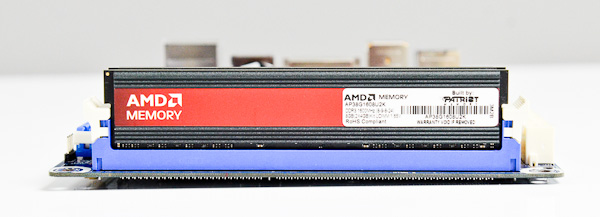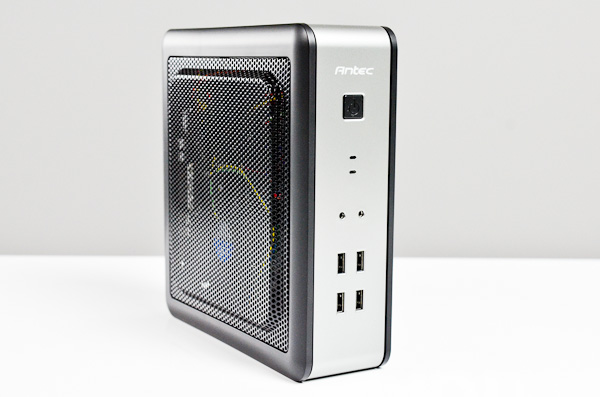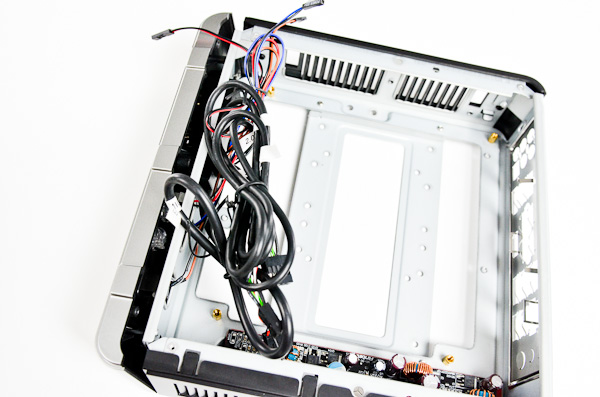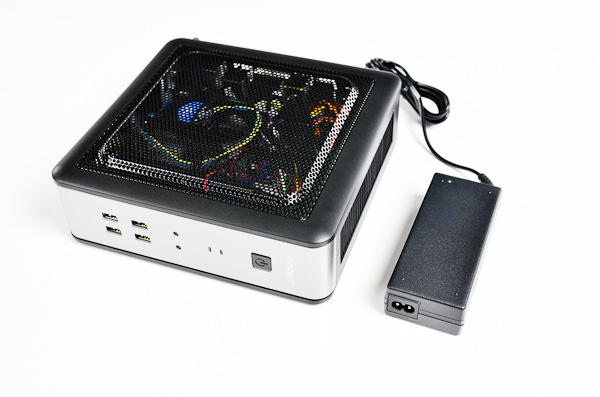Replacing my HTPC with a mini ITX System
by Anand Lal Shimpi on May 24, 2012 1:44 PM EST- Posted in
- Systems
- CPUs
- Intel
- Home Theater
- HTPC
- H77
- TheaterBlog
Free time is hard to come by these days. Since the beginning of the year I've hit Vegas, Barcelona, Santa Clara, New York, Santa Clara (again), Austin, Seattle, Chicago, Santa Clara (again) and Folsom. Before the end of June I'll add Taipei, San Francisco and Seattle again to the list. My travel schedule as of late has taken its toll on a number of things, one of which has been my ability to spend much time in the theater I built a while ago, inspired by this old AVS forum thread.
I've needed to rebuild the HTPC in there for a while. Truth be told, my most reliable HTPC was an old AMD 780G platform (Gigabyte's GA-78GM-S2H) but it lacked the HD audio bitstreaming capabilities that I was looking for. Since then I've tried adding sound cards with bitstream audio support, played with ION, experimented with Boxee, and finally moved to a Clarkdale based HTPC. All of these solutions had their quirks and for whatever reason none was quite as stable and appliance-like as the original 780G. That's usually how things go however. If it ain't broke, don't fix it right?
Times have changed however. The trend towards remote mass storage and smaller form factors applies just as well to HTPCs. Four years ago when I started thinking about the HTPC and theater I wanted a chassis that could accommodate a bunch of 1TB drives for holding all of my content. As a result, the HTPC chassis had to be much bigger than necessary. Improvements on the SoC front meant that I could almost drive the whole theater off of something Atom based, although Intel dropping the ball on serious Atom GPUs and pushing NVIDIA out of the market meant that solution wasn't going to work.
Whenever I finish a big review, especially one that I put together under an incredible time crunch, I like to take a little bit of time to do something fun. Whether it's going out for a drive or actually play one of the many games I'm constantly testing, it's a necessary part of the post-review process. It keeps me sane. After the Zenbook Prime review posted, I had a little bit of time while running data for the follow-up. I also had a stack of hardware I'd been assembling to tackle the sad state of my unstable and presently unracked HTPC. Partially out of a desire to clean the lab up a bit, I started piecing together what I hope will be the spiritual successor to my old 780G HTPC.
I've got a Promise Pegasus R6 with far too much storage driving much of my lab: benchmarks, test data, OS images, you name it. I also have a decent amount of leftover space for HT content so that became my makeshift NAS. It also meant that I didn't need room for any real storage in the HTPC, which further meant that I could go mini-ITX. Originally I expected my HTPC to remain a fixture in the theater but it turned out that I was constantly swapping components in and out as companies sent along HTPC-worthy gear that needed testing. Going mini-ITX and abandoning the idea of something large and rackmounted will make that part of my life a lot easier.
The build started with Intel's DH77DF mini-ITX board. It supports Ivy Bridge but for the time being I'm just using Intel's Pentium G850:
The Pentium G850 is a dual-core Sandy Bridge (32nm) based design with Intel's HD processor graphics (basically an HD 2000 without Quick Sync, BD 3D, Intel Insider and Clear Video HD). I underclocked the CPU to 1.6GHz from its stock 2.9GHz frequency as the decode block is doing much of the heavy lifting here. The stock retail heatsink/fan is capable and quiet enough given that the HTPC ends up tucked away in a corner of the room with audio easily drowning out any noise it would make.
The motherboard happens to have a mini-PCIe/mSATA slot on it, giving my old Intel SSD 310 mSATA drive a purpose in life. Small SSDs make for great HTPC boot drives (silent, cool running, low chance of failure right before you want to watch a movie). The mSATA interface also removes the need for running SATA and power cables, a welcome benefit when building a cramped mini-ITX system.
For memory I needed something low profile, so I ironically turned to a bundle of AMD memory I've been wanting to do something with:
If you didn't get the memo, AMD sort of officially entered the desktop memory market recently. It's a partnership between AMD and Patriot Memory at this point, where AMD selects the components and Patriot validates, distributes and supports the AMD branded DIMMs. There's only a single DRAM vendor approved today although I hear they are trying to expand the program. From AMD's perspective it's a quick way to increase top line revenues, although the memory business isn't extremely profitable. The memory works well and more importantly it's a lot more low profile than most of the high-end DIMMs I have laying around the lab, which works for my needs.
Picking the right mini-ITX chassis was a struggle as I don't believe that there many (any?) good looking mini-ITX HTPC cases on the market today. I've been pushing Antec for years but it turns out that despite the coolness of mini-ITX, motherboards and cases built around the spec just don't sell well. I really do hope this eventually changes as companies like ASUS have been taking the form factor seriously for a while now.
I ended up with Antec's ISK110, an admittedly non-HTPC-looking chassis but one that definitely gets the job done. Assembly was pretty simple once I realized that I had to unscrew and pull the front panel out a bit in order to get the motherboard installed.
The ISK110 uses an external 90W power supply. With my underclocked Pentium G850 the entire system pulls around 23W while watching a movie and peaks at 33W when installing software/doing other more CPU intensive things. Power consumption is a bit higher than I'd like but unfortunately the Intel board doesn't allow user customizable core voltages, so I'm not able to exploit the awesome benefits of voltage scaling.
The box is running Windows 7 and XBMC, while I'll rely on the PS3 for any BDs I haven't had time to rip. I haven't yet watched a full movie on it yet but it worked well in all of my tests thus far. I'm particularly excited about the portability aspect of the machine, especially since I end up moving it around a lot more than I expected to.




























56 Comments
View All Comments
SlyNine - Friday, May 25, 2012 - link
What remote do you use. What skin do you use for XBMC. My biggest problem is making my media center easy to use for everyone else.I'd be interested in the "other" user experience that your media center offers. Do you turn it on by hand every time you start it or do you somehow boot it up via remote?
azimut - Friday, May 25, 2012 - link
I would love to built a such small htpc based on intel but I was I little worried about the 24p bug in Intel gpu.The good thing is that VERY nice solution are coming the artict cooling MC101 Barebone looks very nice!
owan - Friday, May 25, 2012 - link
I too built a mini-ITX HTPC, hoping to downsize from my capable but unwieldy mATX rig in an Antec Fusion Remote case. I wound up building an AMD E-350 rig, which easily handles my rather straightforward BD rips (in mkv) plus a handful of lower bitrate re-encodes. Unfortunately, I ran into a major problem pretty quickly. For whatever reason, the Realtek 8111E implementation for GbE had major issues streaming content over LAN. This would have been a simple fix in a mATX build, just throw in one of the spare intel NICs I had lying around, but in a mini ITX build, the single expansion slot was already slated to hold my InfiniTV4. Ultimately I had to host the CableCard tuner in my main rig and bridge the tuners over the network (thank god Ceton finally released that software) just so I could put a decent NIC in there.Takeaway message:
1) lack of expandability can hurt sometimes
2) its hard finding an ITX board with a decent ethernet chip (aka NOT 8111E)
Taft12 - Friday, May 25, 2012 - link
Realtek NIC chipsets indeed suck, but head to realtek.com and get the driver straight from the source. For me that's worked better than using the driver off the motherboard CD or Windows update.Soulkeeper - Friday, May 25, 2012 - link
Used AMD memory in an intel system funny.MadAd - Saturday, May 26, 2012 - link
I welcome more threads like this, to evolve the desktop PC needs to shrink right now, not next year, or in 5 years time, now.The current motherboard format is too big, PSU companies are just as much to blame. Intel tried to supersede ATX with BTX at one point but the market just ignored it, it was the same size and it didnt help us upgrading from ATX, it was a perfect format back then. With the invasion of tablets laptops and mobile devices there is less of a need to keep a behemoth ATX format machine at home and im sure many of those that do have more space than hardware inside, the format really needs to shrink now to turn PCs into the appliance they are destined to be - but how?
I like ITX, I built a car computer with one many years ago but for a desktop its a couple of inches too small to load a decent amount of hardware on it, corners have to be cut yet mATX still has that bulkyness about it that comes with the ATX format but the only alternative if we want 1x16 + 1x4 + 1xPCI, 4xRam, 6xSATA.
Seems like no one in the PC industry wants to take the reins of the decline and modernise the format properly so small gaming systems and large desktops alike dont have to be constrained by this dinosaur of a case standard.
Last comment, My friend bought an old pc to me to make into something for his daughter - since we built it around 2002 absolutely everything in it was junk by todays standards so when he said 'i guess theres nothing we can reuse if we upgrade it' I had to say 'actually the case is still fine', which just shows how long the standard has been with us.
Its time for a change?
kappa7 - Saturday, May 26, 2012 - link
Nice report!Do you have measured the idle power consumption of the system?
I'm curious to know if the DH77DF is good as the old DH67CF(one of the most power efficient mini-itx board for socket 1155) regarding the idle power consumptions.
Thanks
tipoo - Monday, May 28, 2012 - link
Wouldn't the processor use its lower speeds if it's being underused anyways?Also I use Throttlestop on my processor to set the voltages, I have it so that the highest multiplier uses the same voltage as the lowest and it's perfectly stable, your mileage may vary but that might be worthwhile.
mcquade181 - Monday, May 28, 2012 - link
The big problem I have with Mini-ITX boards is that generally there are no PCI-e expansion slots, which means to add tuners to your HTPC you need to rely on either USB or ethernet based tuners. My experience with USB tuners has not been good.I'm a big user of HTPCs, not just for myself but also friends and relatives. Most that I have built use Micro ATX motherboards, generally the Antec Minuet 350 case, and one or two dual channel DVB-T tuner cards.
WT - Tuesday, May 29, 2012 - link
I am currently using a 780G for my HTPC, the unique MSI 7411 Diva AM2 mATX board with a 5.1 amp as a discrete audio card.I love this board so much that when it died on me about 2 months ago, I briefly looked for another board to replace it, but ended up buying a refurbed Diva board off of Ebay (it had its bad caps replaced - the same thing that did in my board.
So far so good on the 'new' board, and I'm back to watching my DVD library. I know HTPC enthusiasts will scoff at the notion of using WMC, but under my circumstances it works very well for how I view my content.